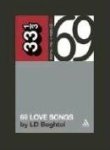Book Review: LD Beghtol's 69 Love Songs: A Field Guide
by dave heaton

LD Beghtol's contribution to Continuum Books' 33 1/3 Series of small books about albums treats its subject – the Magnetic Fields' epic 69 Love Songs - as more than just an album. He treats it as a reservoir of arts and culture, of history and language, of facts and ideas. And that's appropriate, for it's exactly what the album is. Any fan of the album knows its 69 songs are filled with references – to pop-culture icons, to historical figures – but 69 Love Songs: A Field Guide reveals more layers to the album than even the biggest fans are likely aware of. But he does so not just through explaining, but through indulging. He's made this field guide into its own deep river of facts, its own encyclopedia of sorts: fascinating and far-reaching.
Perhaps in part because he was a vocalist on the album itself, Beghtol doesn't approach 69 Love Songs with the reverence of the typical music critic/fanboy, though he clearly loves the songs. And that's why the book succeeds where similar books often fail – there's a charming playfulness to his whole approach to the endeavor. There's a "On This Day in History" list of events that coincided with the album's release, a crossword puzzle related to the album, a goofy (yet still interesting) interview with Stephin Merritt, appendices of facts and resources about the album, a song by song oral-history section with band members, friends, associates, and fans giving recollections and perspectives on each of the songs.
And best of all is the "lexicon" to 69 Love Songs, the most fun and insightful section of the book. Letter by letter he goes through key words related to the album and uses each as a jumping-off point for an exploration of the maze of words and ideas behind the music. Some entries are lyrical references that any fan will immediately recognize ("7, 8 1/2, 9, 10"; "Busby Berkeley Dreams"), others are more general reoccurring subjects (Dancing, New York City). Few of the entries stick closely to the album; rather Beghtol takes the album's approach to life and runs with it, jumping from idea to fact to fact to idea. The entry on the ukulele includes every fact on the instrument you'd ever want to know (who knew William H Macy played was a ukulelist?). The entry on New York City takes us on a specific walk through the city, listing the sights we'd likely experience. The entry on Dakota, Reno includes a lyric the filmmaker wrote in response to Merritt's song. There's footnotes galore (of course) and facts as esoteric as they come. It's a fascinating read in and of itself, a catalogue of people and events and notions and words…above all words, ancient and new (including a how-to guide to making up your own new words.
In the process of playing a rather delightful game, using 69 Love Songs (and by relation, life) as the source, Beghtol gives more insight into the album than any straight critical essay ever could. The album grows in stature, and dimension, as you read. And so does the world around us, really, considering how many interesting bits of information are included here. It's like the Rebecca West quote that Beghtol uses as an opening epigraph says, "You must always believe that life is as extraordinary as music says it is."
Fitting for such an un-ending maze of thoughts and facts (and for our times), there's also a corrolary website that Beghtol made that continues the project outside the boundaries of the book: http://www.69lsbook.com/thebook.html}
Copyright (c) 2007 erasing clouds |
|